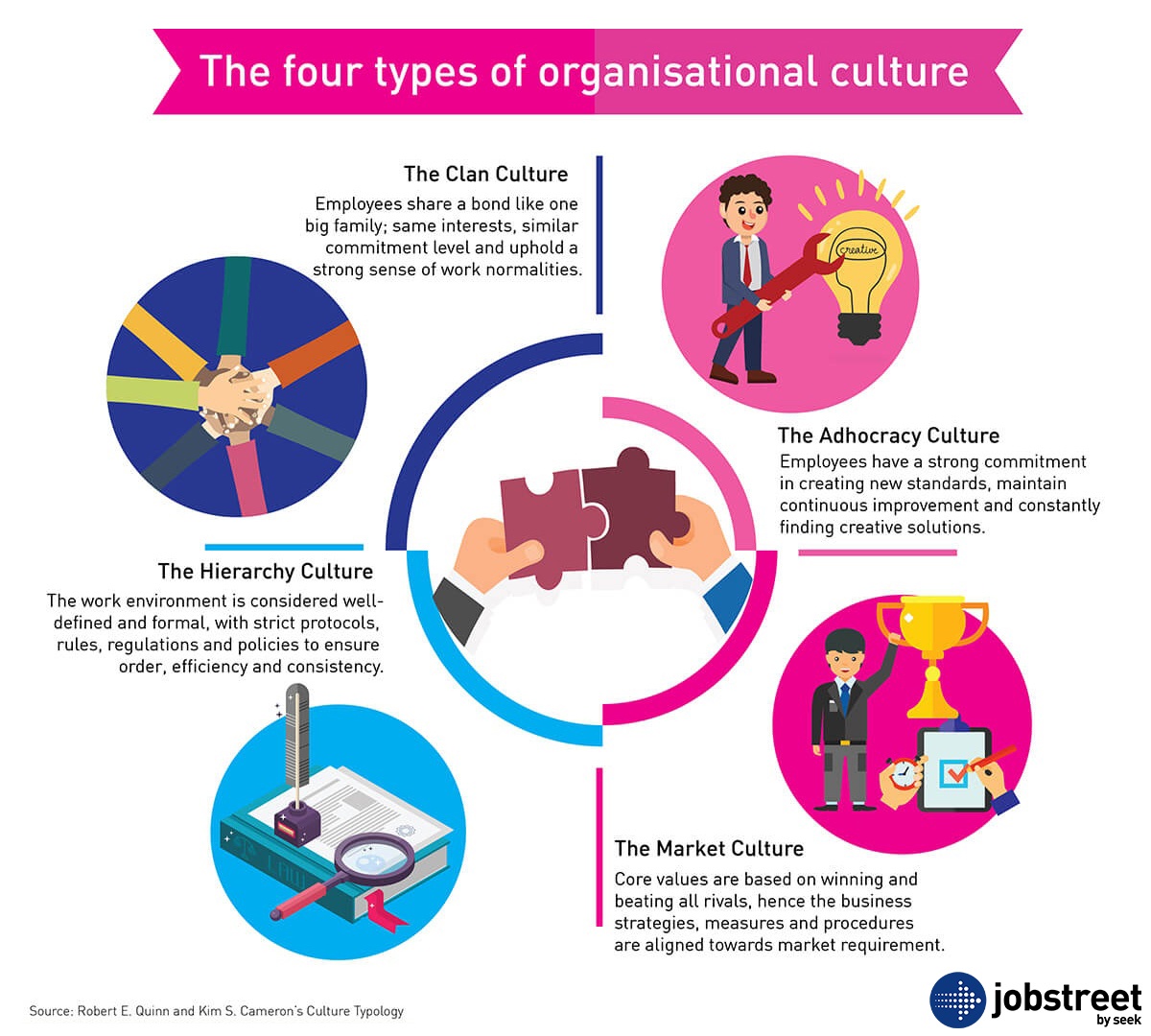
Understanding 4 types of organisational culture to find great talent
There is a phrase that is quite familiar when it comes to bad hires: “He/she just wasn’t a good fit.” Finding the right fit is no easy task and every HR professional knows that employee turnover is often costly. It is estimated that finding a direct replacement could cost as high as 60% of the employee’s annual salary. Pretty steep, huh?
The key to making the right hire is to find a candidate who will be happy and fits well within your organisational culture, not the other way around. So, how do you do this? Before you even start hiring, the first step you need to do is to assess your organisational culture and understand it.
According to Robert E. Quinn and Kim S. Cameron, professors at the University of Michigan in the United States, there are basically four types of organisational culture: Clan, Adhocracy, Market, and Hierarchy. Both Quinn and Cameron developed a 15-minutes survey, called the Organizational Culture Assessment Instrument (OCAI). Based on Quinn and Cameron’s Competing Values Framework Model, the OCAI is a validated tool used for assessing current and preferred organisational culture and is reported to have been used by over 10,000 companies worldwide.

The framework above shows how the four types of organisational culture compete with one another. To determine what type of organisational culture your organisation belongs to, let us take a closer look at these four types of organisational culture:
The Clan Culture
Like its name, the clan culture functions through a united group of people. Employees in this organisational culture tend to share a bond like one big family; they might have the same interests, similar commitment level and uphold a strong sense of work normalities. One of the best advantages of this culture is that it brings synergy to the whole organisation as trust is built through positive relationships in your workforce.
To be the perfect fit, your new hire should ideally be an employee who values and is driven by teamwork, collaboration, open communication and commitment.
The Adhocracy Culture
This culture is seen as the most creative type. The employees and leaders in this organisational culture are both risk takers and innovators. There is a strong commitment in creating new standards, maintaining continuous improvement and constantly finding creative solutions. The management in this organisational culture tends to benefit from innovation and creative new ways employees will find in solving problems.
Your ideal candidate for this organisational culture should have a creative-mind, possess the qualities of an entrepreneur or a visionary; an individual who takes initiative and is a self-starter.
The Market Culture
Result is the only thing that matters in a market-cultured organisation. The employees are often aggressively competitive and leaders are generally tough with high expectations. The core values are based on the importance of winning and beating all rivals, hence the business strategies, measures and procedures are well-aligned towards the demands of the market. The best part about this organisational culture is that top performers are rewarded and highly recognised, encouraging them to go the extra mile for their employers.
If your organisation is result-oriented, look for a candidate who is highly ambitious, competitive and confident in nature. The downside of this culture is that there is a high chance of work stress or employee burnout, therefore it is vital to pick a candidate with the above qualities to avoid a bad hire.
The Hierarchy Culture
The fundamentals of this organisational culture are on structure and control. Widely known as a bureaucratic organisation, the work environment for this organisational culture is considered well-defined and formal, usually with strict protocols, rules, regulations and policies to ensure order, efficiency and consistency. The advantages of this culture lie in the stability, process control and predictability that it gains.
Contrary to popular belief, there are employees who prefer a hierarchy culture. A study revealed that it depends on people’s level of narcissism that determines the acceptance to working in a hierarchical organization. The best way to find out if your candidate is the right fit in a hierarchy culture is to ask them straight up.
Just as how every candidate’s personality is exclusive in his or her own way, a culture is unique to every organisation. Nevertheless, as businesses are affected by factors such as industry trends, new developments and the impact of disruptive technologies, the best organisational culture may not necessary be only one type. It is important to hire employees who can be in sync with your business strategies in order for them to find the right balance between all four types when the need arises.